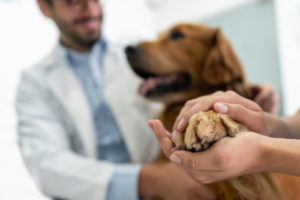Courtesy of: Assisi Animal Health
Dr. Randy Aronson talks about Surgery-free treatment for osteochondrosis dessecans in canines
Osteochondrosis dessecans (OCD lesion) is a painful condition occurring primarily in young large and giant breed dogs. In OCD the bulb of the humerus bone (the humeral head), which connects to the shoulder socket, develops a “flap” that may detach from the bone entirely. This occurs due to a defect in the process that turns cartilage to the bone during the growing phase. This defect results in abnormal cartilage thickening and essentially “starves” cells within the cartilage. Normal wear and tear of running, sitting and walking turn this weak area into a gap at the junction of the bone and cartilage. The resulting inflammation is very uncomfortable for the dog and an owner may notice their dog develop a limp between 4-8 months of age. It can lead to more degenerative joint problems later on if not corrected.
Osteochondrosis dessecans is almost exclusively treated with surgery. The veterinary surgeon will clean out the flap and sometimes fill in the area with stem cells to encourage the growth of new healthy bone. But what about non-surgical options, and pain management for the animal? Since osteochondrosis dessecans is a problem of inflammation and delayed repair, the Assisi Loops is primed to treat the condition.
This is exactly what Dr. Randy D. Aronson, DVM, of P.A.W.S. Tuscon found when he first began using the Assisi Loop at his clinic:
“One of the first cases I used it on was a young golden retriever, about 8 or 9 months old, who had an osteochondrosis dessecans lesion in his shoulder. That’s a condition where the blood vessels don’t innervate the bone properly and therefore he has a deficit in the bone itself as if he had a piece of bone missing.
It’s very painful. He was scheduled for surgery where the vet will go in and excise that area, sometimes even pack it with stem cells.
I talked to the client about several different possibilities including pulsed signal therapy (PST) for this dog. I said, ‘We have a couple of months before this dog has to go into surgery for this. We have initial radiographs so we know the size of the initial defect. Why don’t we put the Assisi Loop on there and see what we can do?’ In a month, it had almost completely filled in and the dog never went to surgery.
In general, we have the Loop as part of our pain management protocol. It assists the body in increasing blood flow, producing natural endorphin release and nitric oxide production, which involves calcium molecules in the anti-inflammatory cascade. We certainly think that the pain and inflammation are improved with the Assisi Loop.”




